Budapest, Hungary – Friday, March 26th, 2010
To travel alone in foreign countries is a true test of character unlike any other I’ve personally experienced. There’s no one else to keep track of your itinerary, no one else to remember the walking directions to get to the train station on time, no help of any kind save for an occasional friendly stranger who may or may not speak any English whatsoever. Even if you go with a single traveling partner who’s no more experienced than you are, at least you’ll have the comfort of knowing that if you become lost, you’ll be lost together. Trying not to think about it, you soon realize that you are in fact thousands of miles from home and if you end up in trouble no one but yourself will be responsible for your safe return.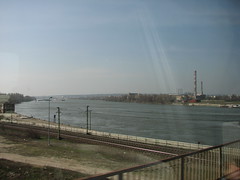 This unquestionably makes traveling alone an adventure, and the stories you bring back with you are far more colorful than when you buy a preplanned, prepackaged bus tour and everything goes according to plan. This is one of those stories.
This unquestionably makes traveling alone an adventure, and the stories you bring back with you are far more colorful than when you buy a preplanned, prepackaged bus tour and everything goes according to plan. This is one of those stories.
But first, some back story. I didn’t have to travel solo. Everyone else in my apartment planned their spring break together in Greece. It would have been a trip the envy of any other college student. Waking up on a beautiful Mediterranean isle, spending all day hanging out on the beach, and at night going into the local villages to get completely drunk and hook up with chicks, getting up the next morning not remembering a thing and then doing it all over again. That easily could have been my spring break story,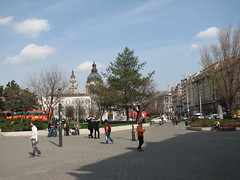 and it also would have been a helluva lot cheaper than the plans I cobbled together requiring multiple airfares, train tickets, small town hotels, etc. Why was I disinclined to go along with all of that? Well, because –duh!– Greece doesn’t have any good roller coasters!1
and it also would have been a helluva lot cheaper than the plans I cobbled together requiring multiple airfares, train tickets, small town hotels, etc. Why was I disinclined to go along with all of that? Well, because –duh!– Greece doesn’t have any good roller coasters!1
My plans were perhaps overambitious. I had a week off in late March to go wherever I wanted, but the problem was not too many parks in Europe were open yet. Disneyland Paris was, and for a while I figured I’d only do a simple trip to Paris to see the sights and then return home to Rome well-rested and with a couple fun stories to tell. But then I got talking to someone else who commented wanting to see some cities further east, which got me to thinking I could go to Prague, Vienna and Budapest instead and fit Disneyland Paris on an extended weekend sometime else. 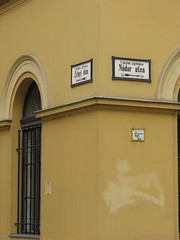 Lo and behold, as soon as I looked into that itinerary, I found that both the Wiener Prater and Budapest’s Vidámpark would be open that time of year. Then literally one day after I thought up that plan, I found Vidámpark made the Screamscape news headlines (seriously, how many times a decade does a place like that make the news?) announcing that it would be shutting its gates permanently for the 2010 season. I could have gone ahead with those plans but the sudden closure robbed my enthusiasm for the idea, so I made silent apologies to the Wiener Prater and went back to mulling over a trip to Paris (the weekend plan wasn’t working anyway.) But with airfare so cheap in Europe I soon discovered it would be economically possible to fly from Paris to Vienna in the €30 to €40 price range and cover both. So then my plans went to encompass Paris for the first four days and Vienna for the next three, and then home. And then I found out that a couple of the German parks I’d like to visit opened for their season starting the Friday of that weekend, so the question only became why wouldn’t I take a train back instead and hit a few of those as well?
Lo and behold, as soon as I looked into that itinerary, I found that both the Wiener Prater and Budapest’s Vidámpark would be open that time of year. Then literally one day after I thought up that plan, I found Vidámpark made the Screamscape news headlines (seriously, how many times a decade does a place like that make the news?) announcing that it would be shutting its gates permanently for the 2010 season. I could have gone ahead with those plans but the sudden closure robbed my enthusiasm for the idea, so I made silent apologies to the Wiener Prater and went back to mulling over a trip to Paris (the weekend plan wasn’t working anyway.) But with airfare so cheap in Europe I soon discovered it would be economically possible to fly from Paris to Vienna in the €30 to €40 price range and cover both. So then my plans went to encompass Paris for the first four days and Vienna for the next three, and then home. And then I found out that a couple of the German parks I’d like to visit opened for their season starting the Friday of that weekend, so the question only became why wouldn’t I take a train back instead and hit a few of those as well?
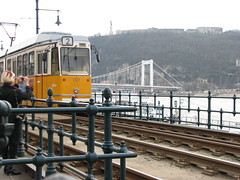 So there, I had my travel plans all lined out. I spent much time drafting different itineraries to figure out how these parts would fit together, then countless hours trying to decipher foreign language websites to figure out where I should be staying, checking Google Maps to print out various walking directions, booking tours of the cities I’d be in, and then trying to piece together an nearly impossible rail journey through Germany. It was two nights before I left as I was up late figuring out what to do with my third day in Vienna that I randomly noticed a new for 2010 coaster listing on the RCDb for the Jetstar, location: Vidámpark. That is not something one would expect to see listed for a park that’s supposed to have gone belly up. I checked their website, and not only did it seem to indicate that it would still be operational,
So there, I had my travel plans all lined out. I spent much time drafting different itineraries to figure out how these parts would fit together, then countless hours trying to decipher foreign language websites to figure out where I should be staying, checking Google Maps to print out various walking directions, booking tours of the cities I’d be in, and then trying to piece together an nearly impossible rail journey through Germany. It was two nights before I left as I was up late figuring out what to do with my third day in Vienna that I randomly noticed a new for 2010 coaster listing on the RCDb for the Jetstar, location: Vidámpark. That is not something one would expect to see listed for a park that’s supposed to have gone belly up. I checked their website, and not only did it seem to indicate that it would still be operational,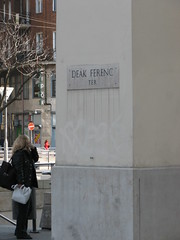 but it even seemed to indicate they would be open until 6:00pm on Friday during my third day in Vienna. One roundtrip day ticket from Vienna to Budapest later, I was now trying to piece together the details for an extremely last-minute excursion behind the iron curtain into a country I knew almost nothing about, except its language appeared to resemble a dialect used by Martians.
but it even seemed to indicate they would be open until 6:00pm on Friday during my third day in Vienna. One roundtrip day ticket from Vienna to Budapest later, I was now trying to piece together the details for an extremely last-minute excursion behind the iron curtain into a country I knew almost nothing about, except its language appeared to resemble a dialect used by Martians.
Disembarking the train, I made my first priority to get some money exchanged for Hungarian Forint. I was told there was a €50 minimum for tourists spending one day in the city, despite the fact that I had already my walking tour prepaid and the only things I needed to buy before catching my 6:10pm departing train were lunch and an admission ticket to Vidámpark. (Incidentally, I still hold a substantial amount of forint in my wallet to this day over four months later, and with the forint even weaker than the Japanese Yen it can be fun to show people a “$5000 bill”.) After using some of the shittiest pay-restroom facilities manned by an old gypsy woman, I went in search of the Metro, where I was sold a three-pack of tickets by a guy near the entrance with a big cardboard and Sharpie sign advertising tickets.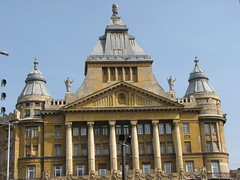 No idea if they were overpriced or the steal of a lifetime let alone if that was the official way one is supposed to buy Metro tickets, but they were valid and the guy spoke English so I won’t complain.
No idea if they were overpriced or the steal of a lifetime let alone if that was the official way one is supposed to buy Metro tickets, but they were valid and the guy spoke English so I won’t complain.
I was told to meet my tour group at 11am at the Deák Ferenc Tér in front of the church. While waiting, I was approached by a large man in his late- twenties who began speaking to me in Hungarian. I stopped him to let him know I only spoke English, at which he then friendly asked if I had any money to give him so he could buy a beer. I appreciated his honesty but told him no, and without any protest he thanked me and went on his way. Ah, the interesting people you encounter while traveling…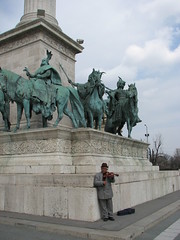
In any event, our tour group eventually convened (which I believe at first consisted of only four people but then we pick up another family of Brits on holiday after the first stop) and I must say it was one of the better walking tours I experienced while in Europe, and exactly what I needed; a way to see as much of the city as possible in a short amount of time while getting a feel for the atmosphere, culture and heritage and enjoying myself at once plus it required very little pre-planning on my part. The main problem was hauling around my 20lb backpack containing everything I’d be living off of for the week and a half of travel everywhere we went (and it was to include hiking up the side of the tall hills dividing the city, but thankfully I seem to have developed a decent stamina that I could manage such a thing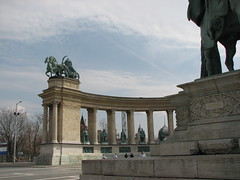 without having it wear me down too greatly.)
without having it wear me down too greatly.)
As you may already know, Budapest is a combination of two cities named Buda and Pest. One thing I did not know is that apparently the proper Magyar pronunciation is “Budapesht”, as the ‘S’ in the language is always spoken like our ‘Sh’. Good to know. I also recall being told that the Hungarian language’s closest relative is actually Finnish (not in the words themselves, but just in the grammatical construction of sentences). I won’t go into detail of the entire Hungarian history but I believe the Magyar people originated as nomads and after settling down on this part of the continent, every chapter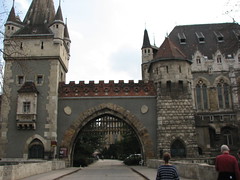 of their history book closed with, “and then they suffered a horrible defeat.” Not surprisingly the Hungarian sense of humor is very dry and dark.
of their history book closed with, “and then they suffered a horrible defeat.” Not surprisingly the Hungarian sense of humor is very dry and dark.
We started taking the Budapest Metro (the world’s second-oldest subway system after the London Underground) to Hósök tere, also known as Heroes’ Square. Surrounding the large ‘Millennium Monument’ were two quarter-circle colonnades with bronze statues of the various heroes of Budapest’s history, of which their most proud was Stephen I,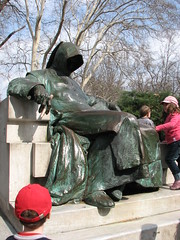 who did something or other to get special recognized by the Pope, a great success for Hungary.
who did something or other to get special recognized by the Pope, a great success for Hungary.
We then moved on to the nearby Vajdahunyad Castle; this was not an authentic historical castle but was built in the late 1800’s as part of a world exhibition that Budapest held. It was a pretty interesting place to see, as the buildings were each designed after one of the major historical architectural styles of the region: Romanic, Gothic, Renaissance and Baroque. Whenever visiting a European city I’m always told such-and-such building was built in the Gothic style but such-and-such is a fantastic example of Baroque, and I just nod my head and go ‘sure’, but seeing these all together in one place does give a good impression of the differences between them and almost made it seem like something I might have seen in Disneyland. Also in the area was the Dementor-like statue of “Anonymous”, where local legend has it if you touch the pen held in his hand you’ll be brought good luck. I obliged.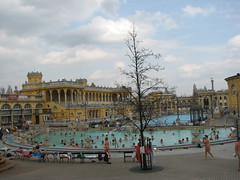
We made our final stop on this side of the city the Széchenyi-gyógyfürdó, aka the Széchenyi Medicinal Bath for which Budapest is famed. It’s a bathhouse supplied by two natural thermal springs, keeping the water at 74°F and 77°F, and is host to one of Hungary’s favorite national pastimes: Water Chess. How it works is you take a chessboard and make it float, so you can play it in the water. Same rules apply as regular chess. Makes sense, right? I was told that Vidámpark was located very close to the area (as our guide told me, “Vidám” means “Happy”, and “Park” means “Park”. Also makes sense, right?) but unfortunately the tour necessitated we start on this side of the city and work our way to the other, so I would have to cross back here at the end of the tour.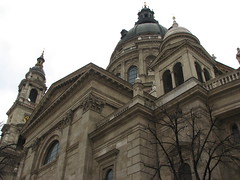
Budapest is far from the same level of glamor found in Paris or Vienna, but from what I experienced it seemed a very interesting city with a lot of history and a lot of character.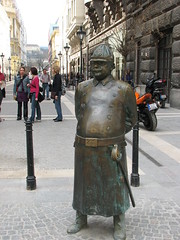 I’ve heard from other travelers before me that Budapest is a must-see city because it’s “cool”. I wasn’t there long enough to confirm or deny that statement, but I could easily see how that could be the case, if I had more time to explore some of the hidden arts and culture corners of the city. I also liked the layout with the different ‘sections’ divided up by the Danube river and the large hills dividing the city. At this time we made our way into the downtown area of Pest to see the Magyar Állami Operaház (aka the Hungarian State Opera House) and the large Szent István-bazilika (aka St. Stephen’s Basilica) which apparently contains the mummified fist of St. Stephen. Also on our way was a bronze pot-bellied police officer statue, where local legend has it if you touch his belly you’ll be brought good luck. I obliged.
I’ve heard from other travelers before me that Budapest is a must-see city because it’s “cool”. I wasn’t there long enough to confirm or deny that statement, but I could easily see how that could be the case, if I had more time to explore some of the hidden arts and culture corners of the city. I also liked the layout with the different ‘sections’ divided up by the Danube river and the large hills dividing the city. At this time we made our way into the downtown area of Pest to see the Magyar Állami Operaház (aka the Hungarian State Opera House) and the large Szent István-bazilika (aka St. Stephen’s Basilica) which apparently contains the mummified fist of St. Stephen. Also on our way was a bronze pot-bellied police officer statue, where local legend has it if you touch his belly you’ll be brought good luck. I obliged.
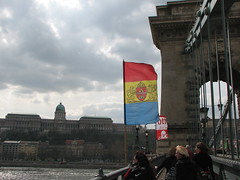 Making our way toward the river we passed some striking buildings done in an Art Nouveau style, and also an oddly memorable statue of “the Little Princess” sitting inconspicuously on the railing next to a tram. One of my favorite stories from the tour concerned the creation of the Széchenyi lánchíd, aka Széchenyi Chain Bridge, built in 1849 as the first bridge connecting
Making our way toward the river we passed some striking buildings done in an Art Nouveau style, and also an oddly memorable statue of “the Little Princess” sitting inconspicuously on the railing next to a tram. One of my favorite stories from the tour concerned the creation of the Széchenyi lánchíd, aka Széchenyi Chain Bridge, built in 1849 as the first bridge connecting 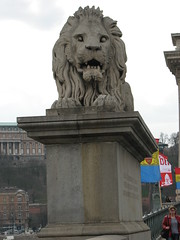 Buda to Pest. It was designed by Englishman William Tierney Clark who was in the city to attend his father’s funeral, but was unable to find a way to cross the river in time. Furious by this inconvenience, he determined to build a bridge for the city so this would never happen again. After ten years of construction the bridge opened and Clark declared it a masterpiece, daring that if anyone could find a flaw, he would jump off the edge into the Danube. However, he did not take into account how starved for entertainment the Magyar people were, and consequently a year-long search for flaws commenced, as the city really wanted to see him jump. Just as they were about to give up, someone claimed they finally found a flaw. Can you guess what it was? The gaping-mouthed lion stone statues flanking either end of the bridge appeared to have no tongues. True to his word, Clark jumped off the bridge… and died.
Buda to Pest. It was designed by Englishman William Tierney Clark who was in the city to attend his father’s funeral, but was unable to find a way to cross the river in time. Furious by this inconvenience, he determined to build a bridge for the city so this would never happen again. After ten years of construction the bridge opened and Clark declared it a masterpiece, daring that if anyone could find a flaw, he would jump off the edge into the Danube. However, he did not take into account how starved for entertainment the Magyar people were, and consequently a year-long search for flaws commenced, as the city really wanted to see him jump. Just as they were about to give up, someone claimed they finally found a flaw. Can you guess what it was? The gaping-mouthed lion stone statues flanking either end of the bridge appeared to have no tongues. True to his word, Clark jumped off the bridge… and died.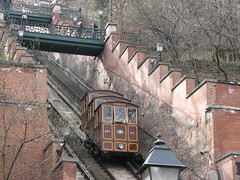
(Actually that last bit was a lie; it was a well prepared for jump and a rescue crew was waiting for him on the river.) After crossing the bridge we took a moment to marvel at the funicular scaling the steep hillside to the Castle District on top. “Right, so now we’ll walk.” Bear in mind I’m still hauling around my fully-loaded backpack, although the way up provided some spectacular views of the city, particularly of the Hungarian Parliament Building (Országház). At the top was a massive statue of the Turul overlooking the city (a falcon of legend which would probably be the name for a roller coaster if Busch Gardens Europe ever opens a Hungarian-themed section) and Budai Vár, aka Buda Castle, which wasn’t the most spectacular of hillside castles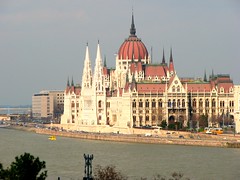 I’d see while in Europe. Beyond the castle was a neat, contemporary-medieval commercial district centered around a Plague Column and Mátyás-templom (aka Mathias Church). Also on top was a bronze statue of Stephen I on horseback, where local legend has it if you climb up and touch the horse’s balls, you’ll be brought good luck. I declined.
I’d see while in Europe. Beyond the castle was a neat, contemporary-medieval commercial district centered around a Plague Column and Mátyás-templom (aka Mathias Church). Also on top was a bronze statue of Stephen I on horseback, where local legend has it if you climb up and touch the horse’s balls, you’ll be brought good luck. I declined.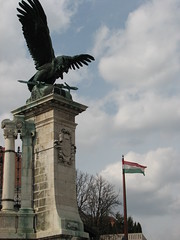
To this point my day had been without dilemma. I arrived in the train station, found the Metro, rode it three stops down to the church, met the tour group, and from there I handed personal responsibility for my travels over to our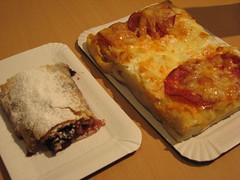 wonderful tour guide who made sure nothing went without hitch. It was a little after 3:00pm, the tour was now over, and I was once again left to my own devices with only a simple set of instructions from my guide on where to get a quick lunch (a very good Hungarian pizza-like bread with a strudel for dessert)
wonderful tour guide who made sure nothing went without hitch. It was a little after 3:00pm, the tour was now over, and I was once again left to my own devices with only a simple set of instructions from my guide on where to get a quick lunch (a very good Hungarian pizza-like bread with a strudel for dessert)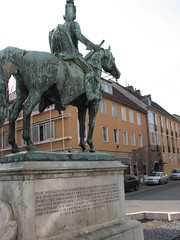 and then back to Vidámpark, from a hillside on the opposite side of the city where no Metro service was present. This would require buses.
and then back to Vidámpark, from a hillside on the opposite side of the city where no Metro service was present. This would require buses.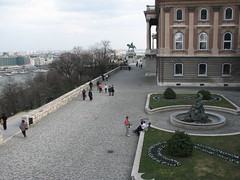
I fucking hate buses. As I was walking up to the stop I saw the #16 bus service labeled for such pull up past me, but I wasn’t able to catch it in time. However, I watched as it curved around a plaza and then stop on the exact opposite side of the road. This bus is still headed for Deák Tér, right? I think that’s what the destination board on the 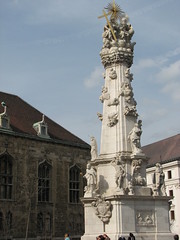 front says (it’s a bit harder to read than the one on the back) so I get on. None of the locals appeared to be paying for anything, so I figure to hold onto my two remaining Metro passes I’d need to get to and from Vidámpark and in case anyone said anything I’d play confused American tourist. After riding for a couple five to ten minutes, I began getting the distinct impression that I was not going down the side of the hill I needed to be in order to get back to where I started my day. I asked some of the other riders (all elderly, wrinkled Hungarians) if any of them spoke English; one old lady replied “a leetle”. I asked if this bus is going to Deák Tér. “Yes, this goes to Dísz Tér.” That doesn’t sound quite right. I don’t know when trying to pronounce a foreign name if speaking more carefully and deliberately helps or hurts the communication process, or if I should say it in the same mumbled, accented way I imagine the locals do. I repeat the name of the stop I require to make sure I was correctly heard. “Oh, Deák Tér, no!” Hmm, apparently when it circled that plaza the service changed from the 16 to Deák Tér to the 16A to Dísz Tér, on the opposite side of the city. Like I said, I fucking hate buses.
front says (it’s a bit harder to read than the one on the back) so I get on. None of the locals appeared to be paying for anything, so I figure to hold onto my two remaining Metro passes I’d need to get to and from Vidámpark and in case anyone said anything I’d play confused American tourist. After riding for a couple five to ten minutes, I began getting the distinct impression that I was not going down the side of the hill I needed to be in order to get back to where I started my day. I asked some of the other riders (all elderly, wrinkled Hungarians) if any of them spoke English; one old lady replied “a leetle”. I asked if this bus is going to Deák Tér. “Yes, this goes to Dísz Tér.” That doesn’t sound quite right. I don’t know when trying to pronounce a foreign name if speaking more carefully and deliberately helps or hurts the communication process, or if I should say it in the same mumbled, accented way I imagine the locals do. I repeat the name of the stop I require to make sure I was correctly heard. “Oh, Deák Tér, no!” Hmm, apparently when it circled that plaza the service changed from the 16 to Deák Tér to the 16A to Dísz Tér, on the opposite side of the city. Like I said, I fucking hate buses.
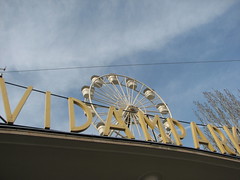 Nevertheless the locals were helpful in pointing out a service on the next stop which would quickly whisk me away to the located I truly did intend, where I needed to take the Metro six stops down to Bajza Utca, and then Vidámpark was less than a ten minute walk away, past the thermal baths. As I approached the gate a couple minutes before 4:00pm, I took my camera
Nevertheless the locals were helpful in pointing out a service on the next stop which would quickly whisk me away to the located I truly did intend, where I needed to take the Metro six stops down to Bajza Utca, and then Vidámpark was less than a ten minute walk away, past the thermal baths. As I approached the gate a couple minutes before 4:00pm, I took my camera out to start getting pictures of the front entrance. The gates were open and manned, and as far as I could tell the rides were operating, although it was immediately clear very few people were at the park that day. It’s not a large park, so an hour and a half should be more than enough time to do everything before leaving to catch my 6:10pm departing train for Vienna. Before reading the next paragraph, I want you to take special notice of the photo on the right: the entry gate is very clearly open.
out to start getting pictures of the front entrance. The gates were open and manned, and as far as I could tell the rides were operating, although it was immediately clear very few people were at the park that day. It’s not a large park, so an hour and a half should be more than enough time to do everything before leaving to catch my 6:10pm departing train for Vienna. Before reading the next paragraph, I want you to take special notice of the photo on the right: the entry gate is very clearly open.
As I took a couple steps back to get a shot of the main entry side, I heard a strange rumbling sound. It couldn’t have been an amusement ride, yet it was coming from the direction of the park. I looked away from the viewfinder to be greeted with a horrifying sight: the large, solid metal barricade was sliding down over the entrance. Sprinting to the entrance,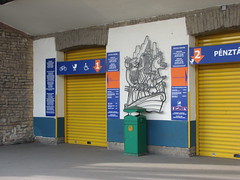 I would have had enough time to get through but stopped when I saw the attendant there who appeared to be waving me away. I thought momentarily, “I know the site said they’re open until 6:00pm and the rides are still running, they must be closing one of the two gates. I hurried over to make sure the other gate was still open – and found it too was only two inches away from being shut. Stepping back to survey the situation, there were indeed only two gates for the entire entrance and both were completely barricaded. I looked carefully at the information sign trying to see if I could decipher any of the cryptic language, and noticed where the hours appeared to be listed (12.00-18.00) a small notice underneath read, “Pénztár Zárás 16:00”. I checked my cell phone. It was 3:58pm (aka 15:58). Apparently they must close the gates to new entrants at 4:00.
I would have had enough time to get through but stopped when I saw the attendant there who appeared to be waving me away. I thought momentarily, “I know the site said they’re open until 6:00pm and the rides are still running, they must be closing one of the two gates. I hurried over to make sure the other gate was still open – and found it too was only two inches away from being shut. Stepping back to survey the situation, there were indeed only two gates for the entire entrance and both were completely barricaded. I looked carefully at the information sign trying to see if I could decipher any of the cryptic language, and noticed where the hours appeared to be listed (12.00-18.00) a small notice underneath read, “Pénztár Zárás 16:00”. I checked my cell phone. It was 3:58pm (aka 15:58). Apparently they must close the gates to new entrants at 4:00.
That’s right. I traveled over 4,600 miles from home all the way to Budapest just to visit this park, and got shut out because I was ten seconds late!
So was that the end of the story? Was I just going to pack it up and go home?
Not even close.
First I went back to the metal gate entrances and began knocking on the doors, gently at first to see if the attendants were still there. “Hello?” I rap harder, making quite a bit of noise. “Hello! I need help!” Pressing my ear against the metal, I hear silence. The park, while still open, cannot have more than 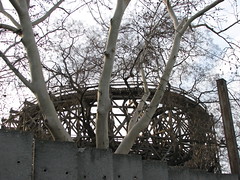 ten guests in it. It’s dead. I move on.
ten guests in it. It’s dead. I move on.
There must be another way to find someone inside. I walk along the outer perimeter wall to see if I can find anyone to talk to. Nothing but high, industrial concrete barricades, very Eastern Bloc-ish. As I get around the back side towards the highway I see the Hullámvasút, which appears to be standing silent. Crap, it might not even be open today. I take a few pictures, trying to accept the sad fact that this may be all I’ll get to experience of one of the few remaining scenic railways in the world, standing on the side of a highway looking up at its silent structure.
But then I hear something, the sound of steel wheels gliding across rails. Looking up I see a lime green train pull off the lift and a small child on board screams in delight. I COULD BE ON THAT! I continue searching, and soon find a large, locked gate I can at least peer through. Wow, this place really is dead. Absolutely no one walking around… save for what appears to be a group of four employees sitting on a bench idly chatting. Yes! I wave my hands to attract their attention, and am greeted with a friendly wave. I wave some more. They get the game and match my waves back. No, come over here! They make a large shrugging motion and go back to chatting. I continue waving desperately, as if I’m in a Hollywood horror movie or island castaway adventure, trying to get the attention of the random passersby who thinks they’re just playing a game, not realizing they’re stranding them to a horrible fate.
gliding across rails. Looking up I see a lime green train pull off the lift and a small child on board screams in delight. I COULD BE ON THAT! I continue searching, and soon find a large, locked gate I can at least peer through. Wow, this place really is dead. Absolutely no one walking around… save for what appears to be a group of four employees sitting on a bench idly chatting. Yes! I wave my hands to attract their attention, and am greeted with a friendly wave. I wave some more. They get the game and match my waves back. No, come over here! They make a large shrugging motion and go back to chatting. I continue waving desperately, as if I’m in a Hollywood horror movie or island castaway adventure, trying to get the attention of the random passersby who thinks they’re just playing a game, not realizing they’re stranding them to a horrible fate. I get another small wave, but it’s clear they not coming over. I squint closer. They don’t even really appear to be employees save for the name tags, possibly they’re just guests? Regardless it’s not working. I turn back the way I came, as it’s clear there’s nothing further down along this side of the perimeter.
I get another small wave, but it’s clear they not coming over. I squint closer. They don’t even really appear to be employees save for the name tags, possibly they’re just guests? Regardless it’s not working. I turn back the way I came, as it’s clear there’s nothing further down along this side of the perimeter.
Back at the park entrance, I can hear those yellow metal barricades laughing at my predicament, a dry, hollow laugh. No one else is around except a mentally handicapped man who wanders by alone, also appearing to vaguely want a way into the Happy Park. I directed a small comment his way about it being closed to see if he even speaks English, but get no acknowledgment back. I figure he’s of no help anyway. Double-checking the entrance sign, it clearly says that they will continue operating for another two hours so I still refuse to give up. There are (few) guests still in the park, so that must mean there’s an exit for them somewhere that I could maybe slip in. I walk along the other perimeter. This seems more promising as it’s a mesh gate I can see into the park. And what’s this: a portly fellow in a white-collar shirt and tie is walking by – must be a manager! I call out for his attention, 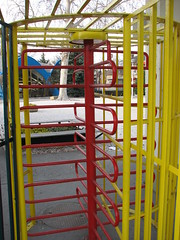 but he gives me a rude flip of the hand and turns a cold shoulder. “Yeah, fuck you too, buddy!”
but he gives me a rude flip of the hand and turns a cold shoulder. “Yeah, fuck you too, buddy!”
Finally I locate the exit. There’s no one around. Could I possibly slip in unnoticed? No, it’s one of those prison-designed, iron revolving gates with anti-rollbacks. I test my size against the width of the bars. Even without my huge backpack, there’s no way it’s possible. Not that I wouldn’t have tried if I thought it possible, such was my desire not to miss that scenic railway.
It seemed ridiculous that I would have to turn around and go home when the park was just a few yards away and still technically operating, but that appeared to be the situation I was in. Walking just a bit further along the wall, I found another large gate. And what’s this, it’s located right next to the park’s security office! I call the attention of one of the employees on duty. She walks over, greets me with a friendly smile, and I ask if there’s a way in.“Oh, uh, no English” she tries saying. I continue through hand gestures my desire to enter the park. I can tell she wants to tell me they closed but doesn’t know how, and my persistence requires her to get her coworker who speaks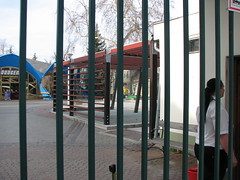 slightly more English than she. “No, closed,” he tells me. “Yes, but I was only 10 seconds late. I’m from America. Can I please get in?” It’s clear he didn’t understand any of this but may have caught the “America” part, because after considering me for a second he says “one moment” and goes back to the office to call someone on the phone. The female guard and I stand there waiting, we both smile awkwardly. I seem to be making progress.
slightly more English than she. “No, closed,” he tells me. “Yes, but I was only 10 seconds late. I’m from America. Can I please get in?” It’s clear he didn’t understand any of this but may have caught the “America” part, because after considering me for a second he says “one moment” and goes back to the office to call someone on the phone. The female guard and I stand there waiting, we both smile awkwardly. I seem to be making progress.
Eventually the manager of the park walks around the side of the building (not the portly man who ignored me earlier), and he speaks English. I start talking away, explaining the situation as I’d been narrating in my head for the past fifteen minutes. He stops me, asking to speak slowly. Okay, I start over, slowly and simply.
“I was late to getting into the park by just a few seconds. I really want to get in. I traveled a very long way just for this park. I run a roller coaster review website, and take pictures of parks from all over the world. I didn’t know the front gates closed at four, otherwise I would have made sure to get here on time. Your website is all in Hungarian. Please, can you make an exception?”
He seemed to understand all of this, then stood there and thought about it for a while. Finally he asked, “You have a website?” He hesitates some more, then decides, “Okay, you can come in” and motioned to the guard to open the gate.
I thanked them profusely as the manager went into the office to retrieve something. “This is a VIP pass” he explained as he handed it to me to clip on my jacket. “You may walk around the park, take as many photos as you want. You cannot ride anything.”
Oh come on! He insists that once the front gates are closed, they can no longer sell any ride passes and he cannot make any exceptions.
“So you are English?” he asks.
“No, I’m all the way from the United States,” trying to imply the much greater distance involved.
“You are probably here for the wooden roller coaster, yes?”
I confirm that is the primary reason for my visit, and insist once more on a ride pass. “I’ll gladly pay twice the normal ticket price due to the inconvenience.” He smiles at my dogged persistence but declines again. However, this time he adds:
“You will get one ride on the wooden roller coaster.”
“Oh, thank you! And the spinning coaster too?”
“No.”
Alright, I won’t push him any further, as it was true that one ride on the Hullámvasút and to take pictures inside the park was all I really needed out of the visit, and compared to where I was ten minutes ago I could hardly be in a position to complain.
I walk with him as he leads me into the park, telling me about their history and ride collection. “We have been open since 1896, and have several rides of interest to historical amusement park groups. The carousel is the oldest and the only one of its type in the world. The roller coaster opened in 1926 and is the most popular ride.”
“You have three other roller coasters, I think?”
He hesitates. “There is one other, the spinning coaster, opened last year.” He must not think their Big Apple counts. I ask him about their original plans to permanently close, which he confirms they’ve had troubles but elaborates no more upon.
“And are you building a new roller coaster for 2010,” I inquire. There appears to be no sight of it anywhere.
“Yes, we are planning to build Jetstar later this summer.”
We arrive at the entrance to the Hullámvasút which is completely deserted, and he goes over to explain the situation to the operators on duty. Before leaving he reminds me that once I am done with my ride I can take as long as I want to take pictures, and then return the pass to the security gate when I’m done. I thank him again for putting up with me (especially since it occurred to me he was giving me all of this for free), and then find a place for my backpack. Just as he’s about to exit the platform I ask one last favor, if I can bring my camera on board. “Okay, but carefully.” I now present for your viewing pleasure, my singular ride on the Hullámvasút:
To provide a few notes on the ride, it was much slower than I was hoping for (most likely because of the brakeman) although this wasn’t a huge problem as there were still some decent drops and being my only ride of the day the fact that it stretched out over four minutes was rather welcome, giving me a chance to savor it without regretting missing out on more re-rides. I think for the layout it would have been better realized as a traditional roller coaster rather than a scenic railway, but it made it a more unique experience for me (especially the open-air cars with zero restraining devices of any kind), and I also enjoyed the aesthetic qualities of some differently styled wooden support structures.
Rather than waste any more words I’ll let this photo slideshow sum up the rest of the time I spent wandering the park, which featured a nice collection of idling rides, most particular of note was the carousel set in a beautiful pavilion with an odd setup of outward-facing horses.
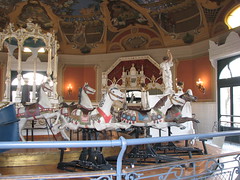 It seems quite a shame that the park is struggling so hard with attendance when they have some really nice attractions of historical importance. Very few parks of this quality exist this far east in Europe. Admittedly that’s possibly part of the reason for their difficulties, as amusement parks simply might not be part of the culture. Considering they have been around for over 100 years and are located centrally in Pest near many other cultural landmarks, I would imagine a stronger local following would have developed, but by the absence of anyone else in the park besides myself and possibly three others, that seemed not the case. Perhaps part of the problem is the addition of newer rides has lent the place a tackier, dirtier carnival feel than it once had, which has been a turn-off for local visitors. If so I’m not sure a new Jetstar will work to reverse that trend, but here’s to hoping they can more permanently stave off bad debts and remain operational at least long enough for me to return one day to try everything else I missed today.
It seems quite a shame that the park is struggling so hard with attendance when they have some really nice attractions of historical importance. Very few parks of this quality exist this far east in Europe. Admittedly that’s possibly part of the reason for their difficulties, as amusement parks simply might not be part of the culture. Considering they have been around for over 100 years and are located centrally in Pest near many other cultural landmarks, I would imagine a stronger local following would have developed, but by the absence of anyone else in the park besides myself and possibly three others, that seemed not the case. Perhaps part of the problem is the addition of newer rides has lent the place a tackier, dirtier carnival feel than it once had, which has been a turn-off for local visitors. If so I’m not sure a new Jetstar will work to reverse that trend, but here’s to hoping they can more permanently stave off bad debts and remain operational at least long enough for me to return one day to try everything else I missed today.

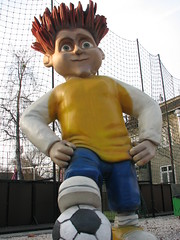 As I turned in my VIP pass I had to laugh slightly at the ridiculousness of the whole situation. While it was still disappointing to only be granted one ride on the Hullámvasút and miss out on everything else, I realized then and there that the story I had to take away from the experience was far more priceless than any additional coaster credits on a production Big Apple. Plus, as I felt my wallet, I never spent a fillér!
As I turned in my VIP pass I had to laugh slightly at the ridiculousness of the whole situation. While it was still disappointing to only be granted one ride on the Hullámvasút and miss out on everything else, I realized then and there that the story I had to take away from the experience was far more priceless than any additional coaster credits on a production Big Apple. Plus, as I felt my wallet, I never spent a fillér!
On my way back to Vienna I listened to Mogwai’s debut album “Young Team” at the request of a friend who was a fan, and because the opening track entitled “Yes! I Am A Long Way From Home” seemed particularly fitting. Nice music, exactly the mood I needed, and a perfect way to close out the day. After hanging around the Vienna train station for a little while and calling my mom to let her know I was okay (I never informed my parents of my last-minute Hungarian add-on) my overnight train to Germany was ready to depart. I had an enjoyable hour-long conversation with an  Austrian girl sharing my train compartment, whom I learned was studying Japanese with the hopes that she’d be ready to travel there sometime in the next two years. My advice was, “don’t worry if you can’t speak the language perfectly just yet, just go and learn as much as you can while there. I didn’t even leave two days of planning before I decided I’d go to Hungary, and I managed to get through my day without any problems. More or less.”
Austrian girl sharing my train compartment, whom I learned was studying Japanese with the hopes that she’d be ready to travel there sometime in the next two years. My advice was, “don’t worry if you can’t speak the language perfectly just yet, just go and learn as much as you can while there. I didn’t even leave two days of planning before I decided I’d go to Hungary, and I managed to get through my day without any problems. More or less.”
With no beds, the sleeping arrangements were somewhat awkward, but after the day I’d been through I wouldn’t have asked for anything more. Tomorrow would be yet another long day, taking me to my first German park, Erlebnispark Tripsdrill.
[1] There was also the minor point that the entire Greek economy was in ruins and the country was undergoing a massive civil upheaval with daily riots and no working police force to restore order at that time. But mostly it was because of the roller coasters.












Comments